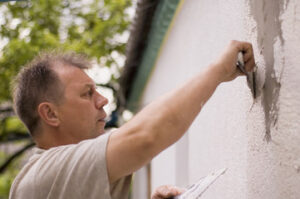The Basics of Stucco Repair
If your stucco has been damaged, there are a few basics you can do to repair it yourself. However, you should hire a professional Stucco Repair Philadelphia if the damage is large or long-lasting. Stucco is a durable material that looks great and typically requires little maintenance. But cracks and holes can occasionally appear, so sealing them is important.
 Whether you have a small crack in your stucco or an entire section of your home needs repair, stucco can be easily repaired. You’ll need a few basic tools, and some simple techniques that any do-it-yourselfer can use. Start by removing loose or damaged pieces of stucco with a masonry chisel and hammer. Break away the stucco until you can see the metal lath or wire mesh underneath it.
Whether you have a small crack in your stucco or an entire section of your home needs repair, stucco can be easily repaired. You’ll need a few basic tools, and some simple techniques that any do-it-yourselfer can use. Start by removing loose or damaged pieces of stucco with a masonry chisel and hammer. Break away the stucco until you can see the metal lath or wire mesh underneath it.
Once you have removed the damaged stucco, clean the metal lath or mesh with a wire brush to ensure no small pieces of stucco are left behind. Then, use a staple gun to secure a piece of grade-D building paper (or felt paper) that’s the same size as the hole you need to patch. Position the lath or paper over the studs or sheathing and fasten it with roofing nails.
Next, mix a batch of quick-setting repair stucco according to manufacturer’s directions. Once it’s ready, apply it to the wall and allow it to dry, which should take less than 30 minutes.
Stucco is a very durable and attractive exterior wall coating. But like any building material, stucco cracks can cause damage to your home if they aren’t repaired.
The best way to repair your stucco cracks is to do it as soon as you see them. This will prevent moisture from seeping into the walls and causing serious health problems.
You should also use a product that will not stain or mildew and can be easily cleaned with water. Some of the better stucco repair products include Red Devil 0646 and Glidden Stucco Caulk.
Step 3: Mix the right kind of stucco for the job. You will need to match the color and texture of the new stucco to that of your existing stucco.
Then, apply a good amount of the right type of stucco to the cracks. This will make the stucco fill and cover up the cracks, but will leave the area looking as good as the original stucco.
Stucco is a popular siding material that is durable, low maintenance, and offers a variety of aesthetic appeals. However, it can also be vulnerable to damage.
If you spot a hole or crack in your stucco wall, you should repair it right away. This is because water will quickly seep behind the surface and cause the stucco to soften.
Small hairline cracks in stucco don’t need much more than a coat of paint to cover them up, but larger ones might require some more serious repairs. Ask your neighbors for advice or check out the home improvement store to find a stucco-friendly paint that will not fade in direct sunlight.
If you’re going to repair holes in your stucco yourself, it’s best to follow the manufacturer’s instructions closely. This will ensure that your work is done correctly and that it’s durable enough to last for years to come.
Stucco is an attractive and durable building material, but it’s also prone to water damage. That’s why it’s important to repair any leaks that may be affecting your stucco siding, and to seal up any holes that have occurred.
Structural issues or moisture penetration points around windows and doors can cause water to seep into the underlying stucco, leading to mold growth and dry rot. Identifying leaks before they become more serious can prevent long-term problems.
A good way to detect leaks in stucco is to take a look at the walls from above and below, looking carefully for tiny cracks and odd bubbles that indicate water is getting behind your house’s exterior. This kind of examination should be done twice a year.
Stucco repair typically involves identifying the cause of the damage, removing any loose or damaged stucco material, and applying a new layer of stucco to the affected area. The repair may involve patching small areas of damage or reapplying stucco to larger sections of the building.
